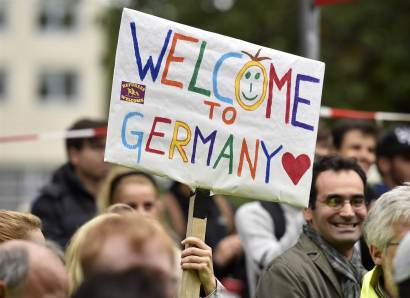By Brian Casey McDermott
6 Conclusion
Those within Germany that are against the incoming of refugees due to the perceived idea that their current culture and way of life would be ruined and or tainted are adhering to the concept and idea of single cultures in many ways. They believe in the old idea that all Germans within the current culture in Germany are a certain and specific way with everything being homogenous such as their culture, language, and even their characteristics as a people as a whole and they use these ideas as arguments for justifying their actions of not wanting their culture to be tainted by those of other nations and backgrounds moving into and starting lives in their country. Firstly this rejects the idea that there truly are very different heterogeneous cultures and sub cultures within Germany itself that adhere to other sets of norms and ways of thinking be it in regards to vertical or horizontal divisions within the culture as mentioned previously in chapter 2.1. The traditional perception that their culture and other cultures function as cultural homogenous spheres or islands leads to them being very xenophobic or being afraid and wary of any “outside” cultures where these different cultures, in their eyes, are completely different from their own and if these different cultural spheres or islands were to collide with their own cultural sphere or island that it would cause problems and cause the makeup and characteristics of their homogenous society to be tainted or ruined. A good and extreme example of that would be the hitherto mention of the anti-immigration group, PEGIDA.
According to Geert Hofstede, a Dutch sociologist, Germany ranks very high on their level of Uncertainty Avoidance or the fear of something different from what they consider to be the norms of their German society (Hofstede, 2001). Uncertainty Avoidance can be defined as “the extent to which people within a society feel threatened by ambiguity and try to avoid ambiguous situations by providing greater predictability through social norms” (Hofstede, 2001). It can be easier understood as when certain cultures have embedded, uncomfortable feelings for the unexpected and reliance and need for an organized social formality to feel stable and minimize stress. On Hofstede’s scale, Germany ranks 65 indicating moderate to high (Hofstede, 2001). According to Hofstede, Germans are very risk-adverse, viewing taking risks as irrational and a set back from productivity. Germany’s moderately high uncertainty avoidance, protocol, and frustration with deviation from social norms could possibly be a leading reason why the new groups of refugees entering their country could pose a risk to the way they have been used to doing things in the eyes of the Germans who oppose their entrance into Germany. When one considers the changes and mixing of different cultures, languages, and cultures that what is today considered as Germany and its people (folk) even in the most basic terms is it clear that it never was a single culture or a homogenous society. With considering the history of what is known today as “Germany” with all its different intermixing of different tribes and peoples each with their own languages, cultural norms, and backgrounds along with the rule of various and always changing governing powers (it was the home of the Celtic tribes for several centuries before Christ and around the time of Christ it was conquered and became part of the Roman Empire for over 200 years) it is clear that Germany was not always the way it is today (Green, 2000). Thinking about the influences of the Celts, Romans, and the various Germanic tribes who controlled the southwestern part of Germany for such a long number of years as well as the mixing and intermingling of their culture with other countries near and far the idea that the current culture in Germany is how it has always been is not valid. It has always been a place where different cultures have flown through and mixed with each other for centuries. Through these examples one can see that Germany is and always has been a transcultural space and can only benefit from allowing their culture to continue its natural process of being changed developed further with the cultures of the incoming refugees and others in order to create an even more advantageous and hybrid culture.
___________________________________________________________________
Contents
2 Traditional Concept of Single Cultures
2.1 Welsch’s Critique of The Traditional Concept of Single Cultures
3 Interculturality and Multiculturality
3.1 Interculturality and Welsch’s Critique
3.2 Multiculturality and Welsch’s Critique
5 Current Situation in Germany
6 Conclusion

Pingback: Transculturality and the Refugees in Germany (IV) | Galicien Zentrum der Universität Heidelberg
Pingback: Transculturality and the Refugees in Germany (V) | Galicien Zentrum der Universität Heidelberg
Pingback: Transculturality and the Refugees in Germany (VI) | Galicien Zentrum der Universität Heidelberg